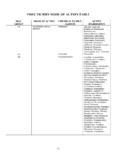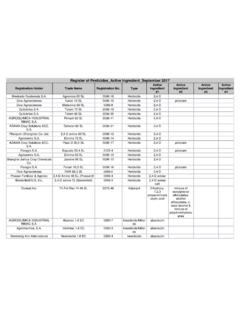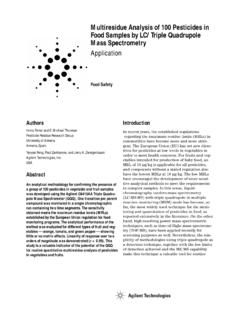Transcription of Chemical Class Chart - trec.ifas.ufl.edu
1 Chemical Class Chart Volume XI. Greenhouse and Nursery Production Insecticides/Miticides Fungicides Herbicides Plant Growth Regulators Technical Service 800-356-4647 REFERENCE GUIDE for ORNAMENTAL PRODUCTION. INSECTICIDES / MITICIDES. RESISTANCE MANAGEMENT. When applying insecticides / miticides, always focus on resistance management. Do not rely on one product or tank mix or the same mode of action. When labels permit, make 2 or 3 applications of a product or tank mix in sequence, then rotate to products with different modes of action. Try to avoid applying the same mode of action to more than one generation of the pest. NOTE: THIS IS ONE OF THE MAIN REASONS WHY IT IS VITALLY IMPORTANT TO PROPERLY DETECT THE PROBLEM. PEST AND KEEP GOOD SPRAY RECORDS. Using insecticides / miticides correctly also includes proper timing, understanding the pest life cycle, and the stage that each product controls.
2 The appropriate and labeled (legal) method of application is also a very important factor to con- sider. Low volume ( ) applications (smoke generator, thermal fog, cold fog, aerosol, and electrostatic) are commonly used in greenhouses. Low volume sprays generally are more effective against adults than immature stages. Use high volume sprays, directed under the leaves for best results against eggs, nymphs and pupae. Always read the label and check with your state or county extension specialists for further information regarding resistance management. **Use Site(s) KEY: GH = Greenhouse; N = Nursery Insecticides / Miticides (by Mode of Action Group and Class ). MOA Use Group* Class Common Name Trade Name REI Site(s)** Company 1A Carbamates Carbaryl Sevin 12 N Bayer Environmental Science Methiocarb Mesurol 24 GH/N Gowan Company 1B Organophosphates Acephate Orthene TT&O 24 GH/N Valent USA Corp.
3 Orthene TR 24 GH Whitmire Micro-Gen Chlorpyrifos DuraGuard 24 GH/N Whitmire Micro-Gen Dursban 50 WP 24 N Dow AgroSciences LLC. Dichlorvos Fulex DDVP Fumigator * GH Fuller System, Inc Dimethoate Dimethoate 267 48 N Micro Flo Company LLC. (Arysta LifeScience). Cygon 2E 48 N Value Garden Supply Malathion Gowan Malathion 8F 12 N Gowan Company Methidathion Supracide 3 days N Gowan Company Oxydemeton-methyl MSR Spray 10 days N Gowan Company Concentrate Phosmet Imidan 70W 24 N Gowan Company 2 Cyclodiene organochlorines Endosulfan Fulex Thiodan Insecticidal * GH Fuller System, Inc Smoke Thionex 24 N Makhteshim Agan, * Depends on greenhouse ventilation Inc. 2009. OHP, Inc. 1. Insecticides / Miticides continued (by Mode of Action Group and Class ). MOA Use Group* Class Common Name Trade Name REI Site(s)** Company 3 Pyrethroids Bifenthrin Talstar 12 GH/N** FMC Corp.
4 ** Greenhouse and/or nursery uses depend on the formulation. Check labels for uses. OnyxPro 12 N FMC Corp. Attain TR 12 GH Whitmire Micro-Gen Attain Greenhouse 12 GH Whitmire Micro-Gen Cyfluthrin Decathlon 12 GH/N OHP, Inc. Fenpropathrin Tame 24 GH/N Valent USA Corp. Fluvalinate Mavrik 12 GH Wellmark International Lambda-Cyhalothrin Scimitar GC 24 GH/N Syngenta Permethrin Astro 12 GH FMC Corp. Perm-Up 12 GH/N United Phosphorus Permethrin EC 12 GH/N** Helena Chemical Co. Ambush 12 GH/N** Amvac Chemical Corp. ** Greenhouse roses only Fulex Permethrin Fumigator * GH Fuller System, Inc. Botanicals Pyrethrins Pyrethrum TR 12 GH Whitmire Micro-Gen Pyreth-It 12 GH/N Whitmire Micro-Gen 4A Neonicotinoids Acetamiprid TriStar 12 GH/N Cleary Chemical Corp. Dinotefuran Safari 12 GH/N Valent USA Corp.
5 Imidacloprid Marathon 12 GH/N OHP, Inc. Thiamethoxam Flagship 12 GH/N Syngenta 4B Botanicals Nicotine Fulex Nicotine Fumigator * GH Fuller System, Inc 5 Spinosyns Spinosad Conserve 4 GH/N Dow AgroSciences LLC. Entrust 4 GH/N Dow AgroSciences LLC 6 Glycosides Abamectin Avid 12 GH/N Syngenta Milbemectin Ultiflora 12 N Gowan Company 7A Juvenile hormone s-Kinoprene Enstar II 12 GH Wellmark International mimics 7B Fenoxycarb Preclude TR 4 GH Whitmire Micro-Gen 7C Pyridine insect Pyriproxyfen Distance 12 GH/N Valent USA Corp. growth regulators * Depends on greenhouse ventilation ** Greenhouse and/or nursery uses depend on the formulation. Check labels for uses. 2009. OHP, Inc. 2. Insecticides / Miticides continued (by Mode of Action Group and Class ). MOA Use Group* Class Common Name Trade Name REI Site(s)** Company 9 A Pyridine azomethines Pymetrozine Endeavor 12 GH/N Syngenta 9B Pyridine carboxamides Flonicamid Aria 12 GH FMC Corp.
6 10A Tetrazines Clofentezine Ovation 12 GH/N Scotts Company Thiazolidinones Hexythiazox Hexygon DF 12 GH/N Gowan Company 10 B 2, 4 - Diphenyloxzoline Etoxazole TetraSan 12 GH/N Valent USA Corp. Derivatives 11 Biopesticides Bacillus thuringiensis DiPel 12 GH/N Valent USA Corp. Kurstaki Deliver 12 GH/N Certis USA, LLC. Bacillus thuringiensis Gnatrol 4 GH/N Valent USA Corp. Israelensis 12 Organotins Fenbutatin-oxide ProMite 48 GH/N SePRO Corp. 13 Pyrroles Chlorfenapyr Pylon 12 GH OHP, Inc. 15 Benzoyl Urea Insect Diflubenzuron Adept 12 GH OHP, Inc. Growth Regulators Dimilin 25W, SC 12 GH/N** OHP, Inc. Novaluron Pedestal 12 GH/N OHP, Inc. 16 Buprofezin Talus 12 GH/N SePRO Corp. 17 Triazine Insect Cyromazine Citation 12 GH/N Syngenta Growth Regulators 18 Growth Regulators Tebufenozide Confirm 4 N Dow AgroSciences LLC 20A Hydramethylnon Amdro Pro 12 N BASF 20B Napthoquinone derivatives Acequinocyl Shuttle O 12 GH/N OHP, Inc.
7 21A Pyridazinones Pyridaben Sanmite 12 GH/N Gowan Company Phenoxypyrazoles Fenpyroximate Akari 12 GH SePRO Corp. 23 Tetronic acids Spiromesifen Judo 12 GH/N OHP, Inc. Tetramic acids spirotetramat Kontos 24 GH/N OHP, Inc. Unknown Carbazates Bifenazate Floramite 4 GH/N OHP, Inc. Biopesticide Insect Azadirachtin Azatin XL 4 GH/N OHP, Inc. Growth Regulators Pyridalyl Overture 12 GH Valent USA Corp. * Depends on greenhouse ventilation ** Greenhouse and/or nursery uses depend on the formulation. Check labels for uses. 2009. OHP, Inc. 3. Insecticides / Miticides continued (by Mode of Action Group and Class ). MOA Use Group* Class Common Name Trade Name REI Site(s)** Company M Biopesticides Beauveria bassiana Naturalis L 4 GH/N OHP, Inc. BotaniGard 4 GH/N BioWorks, Inc. Oils Clarified hydrophobic Triact 70 4 GH/N OHP, Inc.
8 Extract of neem oil Paraffinic oil Ultra-Fine Spray Oil 4 GH/N Whitmire Micro-Gen Petroleum Oil PureSpray Green 4 GH/N Whitmire Micro-Gen Soaps Potassium salts of Insecticidal Soap 40% 12 GH/N Value Garden Supply fatty acids MOA Combination Products MOA Use Codes Classes Common Names Trade Name REI Site(s)** Company 1+3 Organophosphate + Acephate + Tame/Orthene TR 24 GH Whitmire Micro-Gen Pyrethroid Fenpropathrin 1+3 Organophosphate + Chlorpyrifos + DuraPlex TR 24 GH Whitmire Micro-Gen Pyrethroid Cyfluthrin 3+4A Pyrethroid + Cyfluthrin + Discus 12 N OHP, Inc. Neonicotinoid Imidacloprid *Insecticides / Miticides Modes of Action 1. Acetyl cholinesterase inhibitors. Inhibition of the enzyme acetylcholinesterase, interrupting the transmission of nerve impulses 2. GABA-gated chloride channel antagonists: Interferes with GABA receptors of insect neurons, leading to repetitive nervous discharges 3.
9 Sodium channel modulators: Acts as an axonic poison by interfering with the sodium channels of both the peripheral and central nervous system stimulating repetitive nervous discharges, leading to paralysis. 4. Acetylcholine receptor agonists/Antagonists: Binds to nicotinic acetylcholine receptor disrupting nerve transmission. 5. Nicotine acetylcholine receptor agonists (not group 4). 6. Chloride Channel Activators: Interferes with the GABA nerve receptor of insects. 7. Juvenile hormone mimics (Insect growth regulator): Mimic juvenile hormones, which prevent molting from the larval to the adult stage. 9. Compounds of unknown or non-specific mode of action (selective feeding blockers). 10. Compounds of unknown or non-specific target site of action (mite growth inhibitors).
10 11. Microbial disruptors of insect midgut membranes. 12. Inhibition of oxidative phosphorylation at the site of dinitrophenol uncoupling (Disrupt ATP formation). 13. Uncoupler of oxidative phosphorylation (disrupt H proton gradient formation). 15. Inhibit chitin biosynthesis type 0, Lepidopteran 16. Inhibit chitin biosynthesis type 1, Homopteran 17. Molting disruptor, Dipteran 18. Ecdysone agonists/molting disruptors 20. Coupling site II electron transport inhibitors (Complex III). 21. Site I electron transport inhibitor: ( METI acaricides/insecticides). 23. Inhibitors of acetyl CoA carboxylase U Products with unknown or uncertain modes of action M Miscellaneous This list is from the Environmental Protection Agency, in cooperation with the Insecticide Resistance Action Committee (IRAC).







